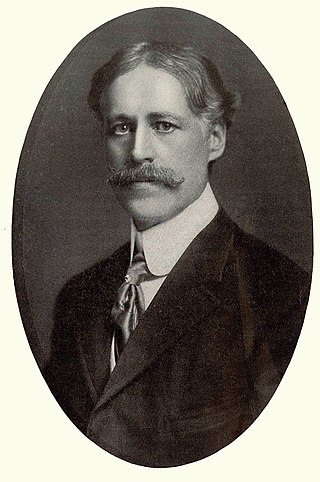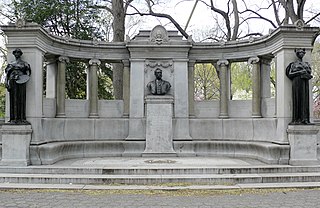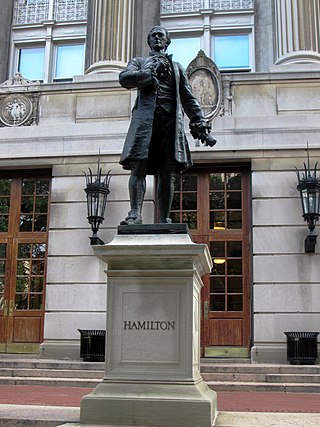
Lee Oscar Lawrie was an American architectural sculptor and a key figure in the American art scene preceding World War II. Over his long career of more than 300 commissions Lawrie's style evolved through Modern Gothic, to Beaux-Arts, Classicism, and, finally, into Moderne or Art Deco.

John Howard Van Amringe was an American educator and mathematician.

William Ordway Partridge was an American sculptor, teacher and author. Among his best-known works are the Shakespeare Monument in Chicago, the equestrian statue of General Grant in Brooklyn, the Pietà at St. Patrick's Cathedral in Manhattan, and the Pocahontas statue in Jamestown, Virginia.

Charles Henry Niehaus, was an American sculptor.

Pompeo Luigi Coppini was an Italian born sculptor who emigrated to the United States. Although his works can be found in Italy, Mexico and a number of U.S. states, the majority of his work can be found in Texas. He is particularly famous for the Alamo Plaza work, Spirit of Sacrifice, a.k.a. The Alamo Cenotaph, as well as numerous statues honoring Texan figures.

William Shakespeare has been commemorated in a number of different statues and memorials around the world, notably his funerary monument in Stratford-upon-Avon ; a statue in Poets' Corner in Westminster Abbey, London, designed by William Kent and executed by Peter Scheemakers (1740); and a statue in New York's Central Park by John Quincy Adams Ward (1872).

Guglielmo Marconi is a public artwork by Attilio Piccirilli, located at the intersection of 16th and Lamont Streets, N.W., in the Mount Pleasant neighborhood of Washington, D.C., United States. It stands as a tribute to Italian inventor Guglielmo Marconi. It was paid for by public subscription and erected in 1941. The artwork was listed on both the District of Columbia Inventory of Historic Sites and the National Register of Historic Places in 2007. It is a contributing property in the Mount Pleasant Historic District. The monument was originally surveyed as part of the Smithsonian's Save Outdoor Sculpture! survey in 1994.

Kauffmann Memorial is a public artwork by American artist William Ordway Partridge, located at Rock Creek Cemetery in Washington, D.C., United States. Kauffmann Memorial was originally surveyed as part of the Smithsonian's Save Outdoor Sculpture! survey in 1993. The memorial is a tribute and grave for Samuel H. Kauffmann, the former owner of the Washington Star and president of the Corcoran Gallery.

Brevet Lt. General Winfield Scott is an equestrian statue in Washington, D.C., that honors career military officer Winfield Scott. The monument stands in the center of Scott Circle, a traffic circle and small park at the convergence of 16th Street, Massachusetts Avenue and Rhode Island Avenue NW. The statue was sculpted by Henry Kirke Brown, whose best-known works include statues of George Washington in New York and Nathanael Greene in Washington, D.C. It was the first of many sculptures honoring Civil War generals that were installed in Washington, D.C.'s traffic circles and squares and was the second statue in the city to honor Scott.

The Stephenson Grand Army of the Republic Memorial, also known as Dr. Benjamin F. Stephenson, is a public artwork in Washington, D.C. honoring Dr. Benjamin F. Stephenson, founder of the Grand Army of the Republic, a fraternal organization for Union veterans. The memorial is sited at Indiana Plaza, located at the intersection of 7th Street, Indiana Avenue, and Pennsylvania Avenue NW in the Penn Quarter neighborhood. The bronze figures were sculpted by J. Massey Rhind, a prominent 20th-century artist. Attendees at the 1909 dedication ceremony included President William Howard Taft, Senator William Warner, and hundreds of Union veterans.

The Richard Morris Hunt Memorial is an exedra of granite and marble, dedicated to the memory of the architect Richard Morris Hunt, designed by Bruce Price with three sculptures by Daniel Chester French, a bust of Hunt, and two flanking statues representing painting and sculpture architecture. The memorial is located at the Central Park perimeter wall, at Fifth Avenue and 70th Street in Manhattan, New York. The bronze sculptures were cast by the Henry-Bonnard Bronze Company of New York.

Fountain for Company H, also known as Second Oregon Company Volunteers, is a 1914 fountain and war memorial designed by John H. Beaver, installed in Portland, Oregon's Plaza Blocks, in the United States. Dedicated to the men of Company H of the 2nd Oregon Volunteer Infantry Regiment killed in service during the Spanish–American War, the limestone and bronze memorial was installed in Lownsdale Square in 1914. It is part of the City of Portland and Multnomah County Public Art Collection courtesy of the Regional Arts & Culture Council. The memorial has been included in published walking tours of Portland.

The statue of Charlie Chaplin in Leicester Square, London, is a work of 1979 by the sculptor John Doubleday. It portrays the actor, comedian and filmmaker in his best-known role, as The Tramp.

A 1926–27 statue of George Washington by Italian American artist Pompeo Coppini, sometimes called George Washington, was installed in northeast Portland, Oregon, United States. The bronze sculpture was the second of three statues of Washington by the artist, following a similar statue installed in Mexico City in 1912 and preceding another installed on the University of Texas at Austin campus in February 1955. The Portland statue was created to commemorate the 1926 sesquicentennial of the Declaration of Independence and dedicated in 1927. It was part of the City of Portland and Multnomah County Public Art Collection courtesy of the Regional Arts & Culture Council. In June 2020, it was toppled by protestors.

A bronze sculpture of American pioneer, newspaper editor and historian Harvey W. Scott (1838–1910) by Gutzon Borglum, sometimes called Harvey Scott or Harvey W. Scott, was installed on Mount Tabor in Portland, Oregon, United States, until being toppled in October 2020.

An outdoor 1908 sculpture of Alexander Hamilton by William Ordway Partridge is installed outside Hamilton Hall on the Columbia University campus in Manhattan, New York, United States.

An outdoor sculpture of Thomas Jefferson by William Ordway Partridge is installed outside the School of Journalism on the Columbia University campus in Manhattan, New York, United States. It was modeled in plaster in 1901 and cast in bronze in 1914 by the New York-based foundry Roman Bronze Works.

The Confederate Memorial, was installed in Jacksonville, Florida's Hemming Park, in the United States. The monument was removed in June 2020.





















